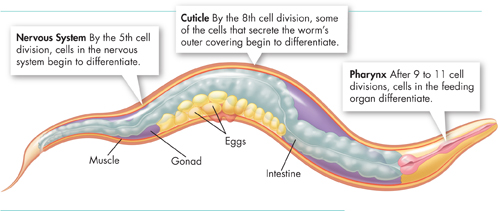Defining Differentiation The process by which cells become specialized is known as differentiation (dif ur en shee AY shun).  During the development of an organism, cells differentiate into many types of cells. A differentiated cell has become, quite literally, different from the embryonic cell that produced it, and specialized to perform certain tasks, such as contraction, photosynthesis, or protection. Our bodies, and the bodies of all multicellular organisms, contain highly differentiated cells that carry out the jobs we need to perform to stay alive.
During the development of an organism, cells differentiate into many types of cells. A differentiated cell has become, quite literally, different from the embryonic cell that produced it, and specialized to perform certain tasks, such as contraction, photosynthesis, or protection. Our bodies, and the bodies of all multicellular organisms, contain highly differentiated cells that carry out the jobs we need to perform to stay alive.

FIGURE 10–19 Differentiation in C. elegans A fertilized egg develops into an adult worm after many cell divisions. Daughter cells from each cell division follow a specific path toward a role as a particular kind of cell.
ddMapping Differentiation The process of differentiation determines a cell's ultimate identity, such as whether it will spend its life as a nerve cell or a muscle cell. In some organisms, a cell's role is rigidly determined at a specific point in the course of development. In the microscopic worm Caenorhabditis elegans, for example, biologists have mapped the outcome of each and every cell division from fertilized egg to adult.
The process of cell differentiation in C. elegans begins with the very first division and continues throughout embryonic development. Figure 10–19 shows when some of the cells found in the adult begin to differentiate during development. Each and every time a new worm develops, the process is the same, resulting in 959 cells with precisely determined functions.
Differentiation in Mammals Other organisms, including mammals like us, go through a more flexible process in which cell differentiation is controlled by a number of interacting factors in the embryo, many of which are still not well understood. What is known, however, is that adult cells generally do reach a point at which their differentiation is complete—when they can no longer become other types of cells.
 In Your Notebook Starting with a single cell, calculate how many cells might result after 4, 8, and 10 cell divisions.
In Your Notebook Starting with a single cell, calculate how many cells might result after 4, 8, and 10 cell divisions.
Table of Contents
- Formulas and Equations
- Applying Formulas and Equations
- Mean, Median, and Mode
- Estimation
- Using Measurements in Calculations
- Effects of Measurement Errors
- Accuracy
- Precision
- Comparing Accuracy and Precision
- Significant Figures
- Calculating With Significant Figures
- Scientific Notation
- Calculating With Scientific Notation
- Dimensional Analysis
- Applying Dimensional Analysis




